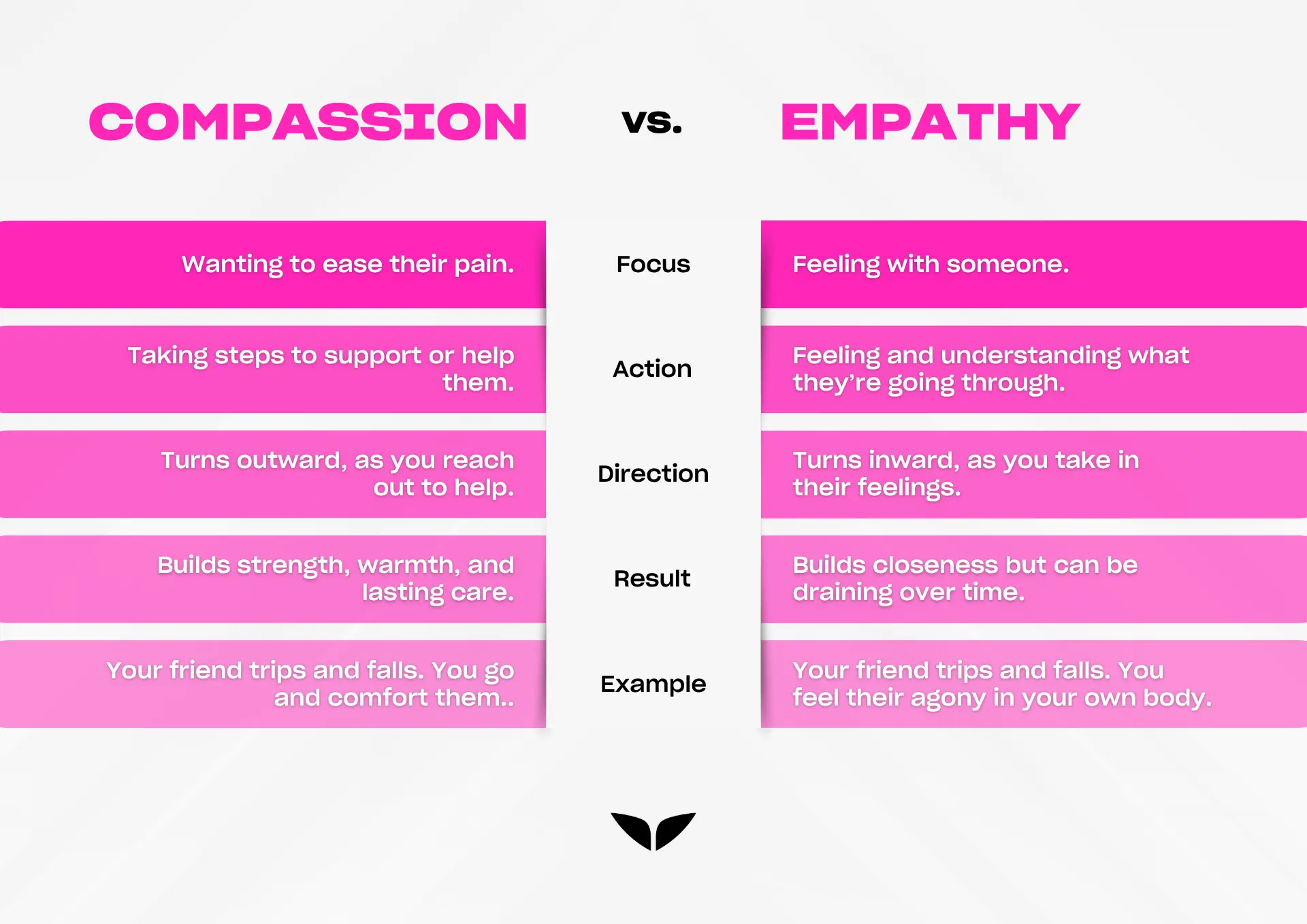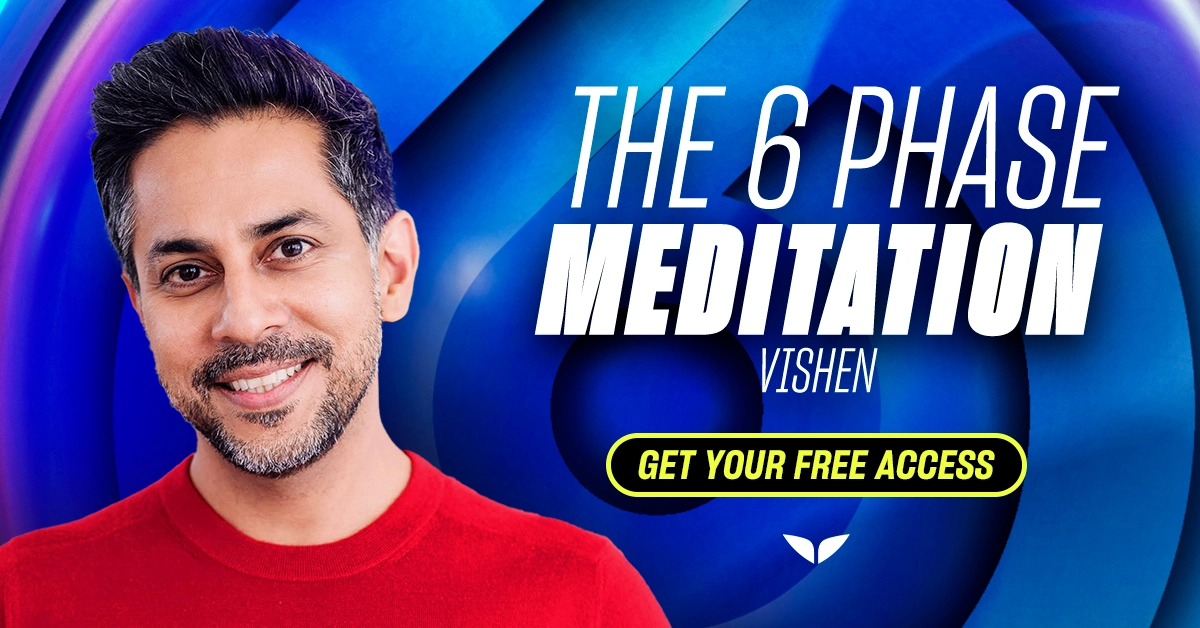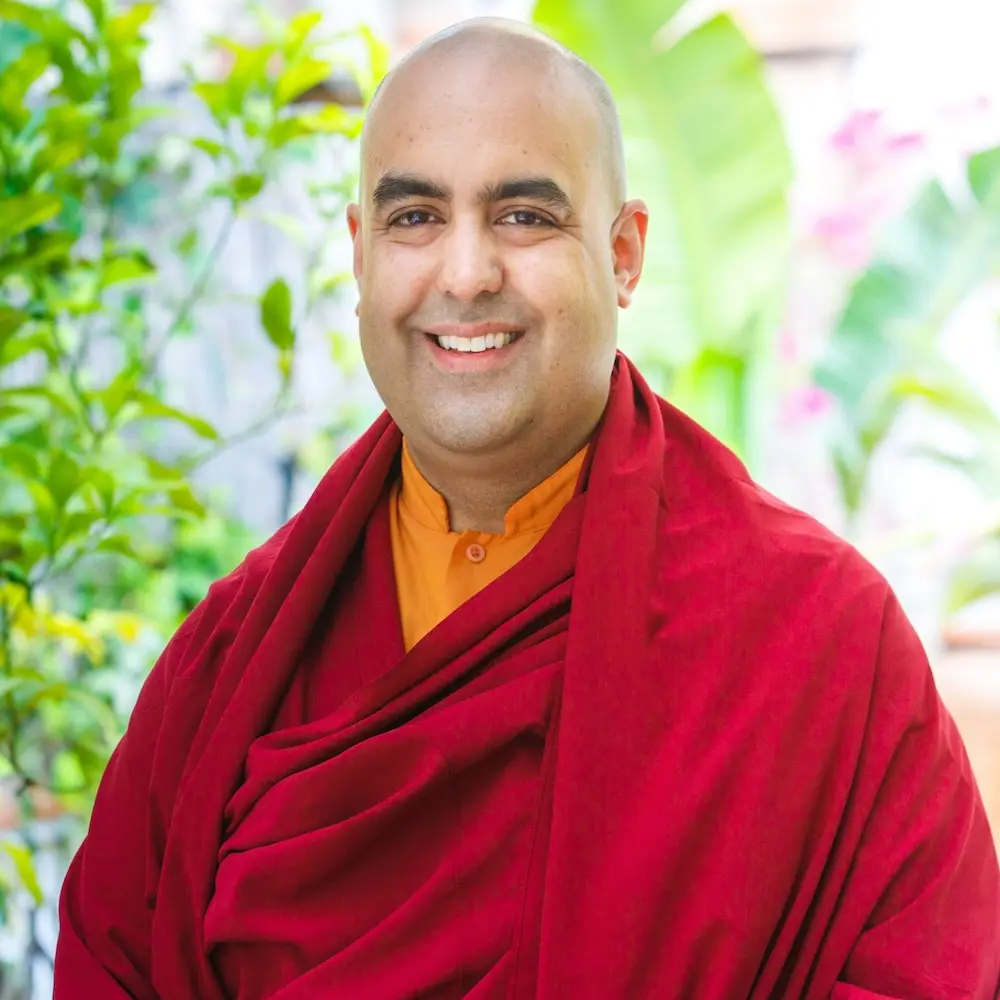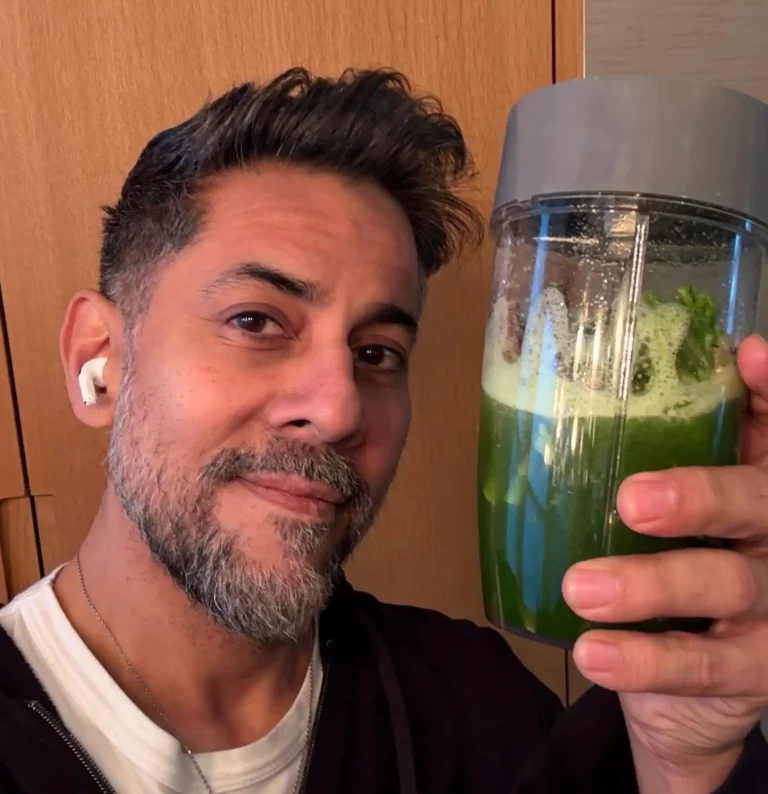Let’s say a friend of yours trips and faceplants onto a concrete floor. There’s a huge thud, and blood is gushing from his nose and a laceration on his eyebrow. Major ouch.
You, too, can feel pain as face meets floor and even the aftershock of it. You start to feel bad for them and rush over to help.
Now, what you may (or may not) realize is, you’ve just experienced empathy and compassion. Do you know which one is which?
That’s the thing with synonyms. We use them interchangeably, like when it comes to compassion vs. empathy.
Not that there’s anything wrong with it. But, like humans, words are unique. There’s a reason a stumble is called a stumble and not a fall.
And when you understand the meaning behind the word, you start responding to the world more consciously instead of just reacting to its pain.
What is empathy?
Empathy is what happens when you feel someone else’s emotions as if they were your own. You’re able to sense what they’re going through without a single word being spoken.
It’s human instinct, really. Research even reveals that when you witness someone else in pain, the anterior insula and the anterior cingulate cortex light up. These are the same brain regions that process your own pain.
It’s a kind of emotional resonance, where you literally feel with others. That’s very much like when your friend’s face high-fived the floor.
But it doesn’t revolve solely around pain. According to psychiatrist Dr. Judith Orloff, you can also mirror joy, fear, curiosity, excitement, and so on.
That’s why empathy isn’t just one thing. There are actually three layers:
- Cognitive empathy is what helps you understand what someone feels.
- Emotional empathy lets you share that feeling in your own body.
- Compassionate empathy moves you to do something about it.
They often overlap, and each activates a different part of the brain that shapes how we connect.
Not only that, but as Dr. Orloff points out in her book, The Genius of Empathy, empathy is its own form of healing, whether you’re giving or receiving it. She writes, “It’s a way of saying you matter to me, the earth matters to me, being kind to myself and others matters to me.”
And that’s the beauty of empathy. It reminds us how deeply we’re wired to care.
What empathy is not
People often romanticize empathy, whether we like to admit it or not. People treat it like a superpower, but half the time, it’s a type of emotional intelligence that we often misuse.
When it leaks out of balance, it turns into something that looks like care but quietly empties you. So here’s what empathy is not:
- A rescue mission. It doesn’t pull people out of pain.
- An emotional sponge. It doesn’t absorb everything it feels.
- A performance. It doesn’t need to be seen to be real.
- A weakness. It doesn’t make you fragile.
- The same as sympathy. It doesn’t watch from a distance.
- A moral badge. It doesn’t prove goodness.
- A guarantee of truth. It doesn’t always understand the story.
The fact of the matter is, empathy loses its strength when it’s confused with emotional overreach or self-sacrifice. It’s meant to be the bridge, not the destination.
And what waits on the other side is compassion.
What is compassion?
If empathy lets you feel someone’s pain, compassion moves you to ease it. It’s the natural next step when understanding turns into care. So, in the instance of your friend falling, it would be when you feel bad and go over to help.
“Compassion is expressing the intention of moving from judgment to caring, from isolation to connection, from indifference or dislike to understanding,” explains Vishen, the founder of Mindvalley, in his 6 Phase Meditation program.
Even across traditions, compassion has been described as the highest form of emotional maturity. In Buddhism, it’s karuṇā, which is the willingness to stay open in the presence of pain. In psychology, it’s seen as the balance between sensitivity and strength.
Neuroscience finds that the same brain regions that handle love and reward also activate compassion. They create feelings of warmth and motivation, and that’s why practicing this emotional state can leave you more energized, not less.
“All of us can go from being judgmental to being truly loving and kind,” Vishen says. And when you do that, “you’re not just better to the people around you. The world feels better because [with] everyone around you, you start understanding that they are human just like you.”
What compassion is not
People often speak of compassion as a virtue, but that halo effect it has can often blur its truth. So here’s what compassion is not:
- Pity. It doesn’t look down on pain.
- Martyrdom. It doesn’t ask you to burn out.
- Saviorism. It doesn’t try to fix people.
- Forced positivity. It doesn’t fake calm or light.
- A transaction. It doesn’t keep score.
According to Vishen, it’s easy to underestimate compassion. “For the longest time in society,” he says in an interview with Jay Shetty, “we thought kindness is [sic] associated with weakness.”
But compassion, he goes on to explain, is like a muscle. “When you train it, you become more loving.”
Understanding compassion vs. empathy
When you’re looking at empathy vs. compassion on the surface, they can seem like one and the same. But when you look at them side by side, you’ll see why each deserves to stand as its own word.
| Aspect | Empathy | Compassion |
| Focus | Feeling with someone | Wanting to ease their suffering |
| Action | An emotional response that helps you understand what they’re going through | Taking conscious steps to support or relieve pain |
| Direction | Turns inward as you reflect and internalize another’s feelings | Turns outward as you channel care into action |
| Result | Builds emotional connection but can lead to empathic distress when unregulated | Builds resilience and sustainable connection through positive motivation |
| Example: Your friend trips and falls… | You feel their agony in your own body | You put into action what you’ve learned about how to comfort someone |

Empathy vs. sympathy vs. compassion vs. pity
So you’ve got the comparison between empathy and compassion. But there are a few others that often get thrown into the mix that, if you’re not a native English speaker, might get you thinking, Goodness, what now …
Buddhist monk Gelong Thubten has an opinion about this (specifically compassion). In his Becoming More Loving program on Mindvalley, he says, “Sometimes I think when people hear the word compassion, they maybe mix it up with an idea of pity or looking down on somebody, or just feeling a very strong kind of empathy and feeling unhappy because others are suffering.”
In the case of your friend faceplanting, when do you feel empathy vs. sympathy vs. compassion? And what about pity?
So take a look at all four, side by side:
| Aspect | Pity | Sympathy | Empathy | Compassion |
| Focus | Observing someone’s suffering from a distance | Acknowledging someone’s hardship | Feeling another’s emotions as your own | Wanting to ease another’s suffering |
| Action | Feeling sorry for them | Offering comfort or words of support | Emotionally resonating and connecting | Taking action to support or relieve pain |
| Direction | Shallow | Moderate | Deep | Deepest |
| Result | Creates separation and hierarchy | Creates understanding but keeps emotional distance | Builds closeness but can lead to emotional fatigue | Creates sustained connection and emotional balance |
| Example: Your friend fell… | You think, “poor thing.” | You say to them, “I’m so sorry; that must’ve hurt.” | You agonize over the pain with them. | You hold space for them and help them heal over time. |
What is more important, compassion or empathy?
The thing with these types of emotions is that they work together as parts of the same emotional intelligence. Even in one scenario, you can move through them fluidly, so you don’t really have to choose to feel one over the other.
“Empathy and compassion play a central role in healing,” Dr. Orloff explains.
The former opens you up to another person’s world. However, too much of it can flood your system and blur the edges of where you end and they begin.
The latter then steadies that response. It acts as the regulator and turns raw feeling into grounded care.
So it’s not so much about compassion vs. empathy but more about how you can get them to work in balance. When you can do that, you’re able to stay connected without collapsing, aware without absorbing, and present without losing yourself.
You can’t ignore your own needs and expect to heal yourself. It just won’t work.
— Dr. Judith Orloff, psychiatrist and author of The Genius of Empathy
How to cultivate compassion and empathy in an authentic way
Chances are, you’re in touch with your empathetic and compassionate side. But if you’d like to strengthen it further, these expert-backed practices can guide the way.
1. Start with self-empathy
“You can’t ignore your own needs and expect to heal yourself,” Dr. Orloff points out. “It just won’t work.”
That’s the whole point of self-empathy. It asks you to slow down and notice what’s happening inside before tuning in to anyone else. And when you do so, research says, your brain can calm stress, steady your emotions, and make it easier to connect with others.
The fact of the matter is, when you understand your own emotions, you’re able to stop projecting them onto others. What’s more, you can communicate more clearly, react less, and listen better.
There are a few things you can do to work on this:
- Notice how you feel. Pause for a moment during your day and check in with your body—your shoulders, your breath, your heartbeat. Ask yourself, “What am I feeling right now?” and let the answer come without judgment.
- Grounding techniques like deep breathing, walking in nature, or journaling to process emotion instead of suppressing it.
- Gentle self-talk. Speak to yourself with patience, not pressure.
“How you treat yourself affects your health and well-being,” says Dr. Orloff. And whether you’re in pain or pain-free, happy or sad, centered or scattered, both are okay. “You are on your own side in all circumstances.”
2. Build healthy boundaries
Setting boundaries isn’t often considered a skill. But it’s one that’s part of Dr. Orloff’s teachings.
“This skill is the foundation of healthy relationships and helps preserve your sensitivities,” she explains. Research shows that people with clear emotional boundaries experience lower stress and less burnout.
The thing is, when you’re cultivating empathy without having boundaries in place, burnout and empathy fatigue (where you have nothing left to give to others or yourself) can occur. Dr. Orloff puts it as “there are no guardrails to hold on to or limitations to keep in mind.” And that’s a huge problem.
So what does setting these boundaries look like?
- Repeat this affirmation. “It is not my job to take on other people’s pain. I can be caring without exhausting myself.”
- Practice saying no without guilt. It also means knowing your limits and expressing them kindly but firmly so you can care for others without neglecting yourself.
Dr. Orloff herself had to learn to do this, respectfully, of course. And she found that her sense of self-worth became stronger. She says, “Once I could catch this pattern and show it more love, I didn’t give it the power to take me down.”
3. Put empathy in action
There are plenty of ways you can start implementing empathy:
- Listen actively. Give your full attention without planning your reply.
- Be curious. Ask questions that invite understanding instead of judgment.
- Stay open. Let people feel safe to share without fearing correction or critique.
They’re small actions, sure. But because they build trust, ease tension, and remind people they’re seen, their impact is incredible.
“Cultivating empathy is peaceful warrior training,” says Dr. Orloff. “You will learn to be both strong and loving, neither a pushover nor rigid.”
And over time, that kind of empathy naturally grows into compassion.
4. Practice self-compassion
Compassion is a discipline of the heart. And on that, Gelong is an expert. As a matter of fact, his Becoming More Loving program centers on understanding it and expanding yours until it becomes a way of being.
So here’s what he suggests doing for self-compassion:
- Calm your mind through simple breathing meditation.
- Each time you notice your mind wandering, gently bring it back.
This is training in forgiveness. And it’s compassion in its most practical form: meeting yourself with patience instead of frustration.
“It’s really a sense of expanding the heart,” Gelong explains. “It’s a sense of connecting with all sentient beings. A sense of something really limitless, something unconditional, something very pure.”
Once you’re able to do that for yourself, then it’s time to expand that feeling outward.
“We want to move beyond the boundaries of our limiting self, our limiting ego,” Gelong adds. Begin with someone you love, move to strangers, and, when you’re ready, include everyone, even those who challenge you.
5. Set compassion as your intention
Compassion is one of the six phases of Vishen’s incredibly powerful and prominent meditation program. And for a good reason.
“Compassion is about surrendering to the best version of yourself,” he says. Research from the HeartMath Institute shows that it creates heart coherence, where your emotions, mind, and body fall into harmony. That’s the energy you radiate when you live from intention instead of reaction.
To begin to learn how to do that, Vishen teaches a simple yet profound exercise:
- Visualize someone you love, like a partner, a child, or even a pet.
- Then, feel the warmth of that love in your heart. See that love as light, and with each breath, expand it.
- Fill yourself with it first, then your home, your neighborhood, your city, and eventually the entire planet.
This is what he means, as previously mentioned, by compassion being an expression of “the intention of moving from judgment to caring, from isolation to connection, from indifference or dislike to understanding.”
Each time you practice it, you raise the emotional field around you. And in doing so, you remind others to do the same.
Compassion vs. empathy: real-life examples
Seeing others in action doing good has a contagious effect. Like when someone pays for a stranger’s coffee, and suddenly everyone in line wants to do the same.
This is what’s known as moral elevation. Research shows that when we witness someone doing good, our brains release oxytocin and activate the same neural circuits linked to connection and care.
The world feels better because [with] everyone around you, you start understanding that they are human just like you.
— Vishen, founder of Mindvalley and trainer of the 6 Phase Meditation program
Here are a few empathy vs. compassion examples in real life. May it inspire you to do the same.
Empathy
Letting someone else be right. Dr. Orloff relays the story of a friend who was certain her daughter’s relationship was doomed. Instead of arguing, Dr. Orloff simply said, “Okay, you seem certain,” and left it there. Releasing the urge to be right allowed her friend to feel heard (even if her prediction didn’t come true). And that made space for connection.
When a story touches the heart. Photographer Brandon Stanton, the creator of Humans of New York, once stopped a middle school student named Vidal on the streets of Brooklyn. The boy spoke about his principal, Ms. Lopez, and how she inspired him every day. Stanton was deeply moved by the way Vidal described her, and that simple moment of listening eventually led to a collaborative campaign to fund a school trip to Harvard.
Reaching out to be understood. In 2004, a man in Sydney known as Juan Mann stood in a busy mall holding a cardboard sign that read “Free Hugs.” After feeling lonely and disconnected, he sensed others might feel the same. A simple hug became his way of saying, “I see you. I feel it too.”
Compassion
Choosing understanding over judgment. After the city reopened from lockdown, Vishen went to a restaurant with a friend. The service was slow, the coffee arrived cold, and the food took ages. When the bill came, instead of complaining, he left the waitress a generous tip. He chose to see her situation through compassion: the stress of returning to work, the exhaustion of long shifts, and the pressure of serving a packed restaurant after months of uncertainty.
The heart of leadership. After 27 years in prison, Nelson Mandela chose unity over revenge. As president of South Africa, he embraced the national rugby team, the Springboks (who were once seen as a symbol of apartheid), and encouraged the nation to support them. It was a moment of profound compassion: the decision to lead with forgiveness, to act from understanding rather than anger.
Self-compassion in healing. Penny Winn, a writer from the United States, discovered The 6 Phase Meditation while struggling with PTSD. Searching for calm one night, she found Vishen’s guided meditation on YouTube and began using it to manage her anxiety and reconnect with herself.
“His ideas on compassion, love, forgiveness, and taking personal responsibility for your development towards the next three years has really moved me forward in my PTSD and spiritual growth,” she shares. Because, sometimes, gentleness is what helps you begin again.
Frequently asked questions
Can you have compassion without empathy?
Yes, it’s possible. Unlike empathy, compassion doesn’t rely on emotional resonance alone. It can also arise from conscious intention.
As Dr. Orloff explains, “Compassion is often a response to empathizing with someone that can spark our impulse to help, but not everyone with empathy is spurred into action.”
In other words, empathy can open the door to compassion, but it’s not the only way in. You can consciously choose to act with care and understanding even when you don’t feel another person’s pain.
That’s why doctors, therapists, and caregivers practice cultivating compassion. It allows them to stay kind and effective without emotional overload.
What is the difference between empathy, altruism, and compassion?
Empathy lets you feel. Compassion moves you to care. And altruism? It compels you to act.
They often work together but aren’t dependent on each other. Empathy can lead to compassion, and compassion can inspire altruism.
Yet, you can also have altruism without empathy or compassion without emotional resonance.
Is there a dark side to empathy?
There can be. Empathy, while beautiful, has limits. When you take on too much of another person’s pain, your nervous system can’t tell where you end and they begin. Experts call this state empathetic distress.
Research from the Max Planck Institute also found that excessive empathy activates the same brain regions as physical pain. So, without regulation, this can lead to burnout, anxiety, and avoidance.
That’s why empathy alone isn’t enough. It needs the stabilizing presence of compassion.
Become a changemaker
You’ve explored empathy. You’ve felt compassion. Now imagine turning both into a daily practice that rewires how you think, feel, and move through the world.
That’s what Vishen Lakhiani’s 6 Phase Meditation does. In just 20 minutes a day, you’ll move through six powerful phases designed to awaken love, gratitude, forgiveness, vision, mastery, and blessing. And with it, you’ll:
- Train your mind to stay calm and clear, even in chaos.
- Open your heart to deeper compassion and connection.
- Live each day with purpose, focus, and joy.
World-class athletes, artists, and leaders use this radically practical meditation. One such person is Bianca Andreescu, a professional tennis player who beat Serena Williams in the 2019 US Open. She shares:
It has definitely changed my life, and just know that you’re not only changing my life, but you also change millions of lives.
You can now access the 6 Phase Meditation program for free and discover how quickly your inner world can transform your outer one.
Welcome in.









